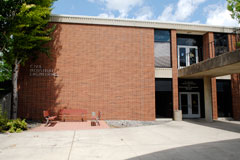Apr 15 2010
Researchers have developed two types of microelectromechanical systems (MEMS)-based wireless sensors that are capable of monitoring moisture and temperature inside concrete structures, thus helping in remote monitoring of concrete structures.
 North Dakota University Civil and Industrial Engineering Building
North Dakota University Civil and Industrial Engineering Building
These scientists used long gauge-based nanotube sensors to detect cracks during the feasibility study. The development promises new applications in the civil engineering field. Nanosensors and MEMS devices are already utilized in a broad range of scientific and engineering domain like medicine, military, communication, and transportation.
The International Journal of Materials and Structural Integrity has published a feasibility study that indicates how nanotechnology-based low-cost wireless sensors could be utilized for alerting civil engineers to the presence of damages and problematic cracks in bridges, buildings, and various structures before they emerge dangerous.
If monitoring of structures is not done in a periodic and timely fashion minor problems like fissures and cracks will become serious problems. This will result in damage to the structures. The improvement of safety in structures requires continual monitoring systems. Wireless and nanotechnology based systems could be the right answer for such eventualities, according to the researchers.
The Fargo-based North Dakota State University, Department of Construction Engineering and Management’s Mohamed Saafi, and the Alabama A&M University, Department of Engineering Technology’s team, highlight the fact that the civil structures are susceptible to uncontrollable and continual damage processes in their service lifespan. Such damage is likely due to non-maintenance, earth tremors, materials ageing and weather.
The team elaborated that properly designed nanotechnology- and wireless-based sensors can be embedded in the concrete structures. These sensors will function as self-sensing concrete structures. These sensors will collect and send information related to the concrete structure health through the detection of miniature cracks and identifying the deterioration rate of the vital parameters in the structure. These parameters include carbon dioxide, temperature, acidity, chloride, and moisture levels. Each one of these could depict a reduction of structural integrity.